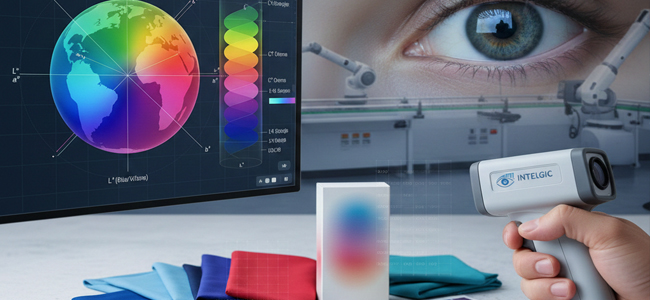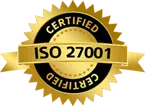Why Modern Color Measurement Depends on These Perceptually Uniform Color Models
Color is everywhere—on products, packaging, textiles, screens, and printed materials. But accurately measuring color is far more complex than simply looking at RGB values. Human eyes see color differently under different lighting, surfaces, and conditions. To create color standards that align with human perception, color scientists developed advanced color spaces such as CIELAB (or Lab) and LCh.

These color spaces are now the foundation of color measurement, quality control, printing, textiles, imaging, and machine vision—including Intelgic’s Color Shade & Design Matching Inspection system.
This article explains, in simple yet detailed terms, what CIELAB and LCh color spaces are, why they were created, and how they are used in modern color evaluation.
The Problem with Basic Color Models (RGB and CMYK)
Before understanding CIELAB and LCh, let’s first understand why basic color spaces like RGB and CMYK are not suitable for scientific color comparison.
RGB Limitations
- Device-dependent (every camera and monitor displays RGB differently)
- Not perceptually uniform
- A small numerical change may not match a small perceptual change
CMYK Limitations
- Used for print manufacturing, not color measurement
- Device and ink dependent
- Not linear
- Inconsistent across printers and substrates

Because of these limitations, scientists needed a device-independent and perceptually uniform color space.
Enter CIELAB: A Device-Independent Color Space (1976)
The CIELAB color space—also called Lab or CIE L*a*b*—was created by the International Commission on Illumination (CIE) in 1976.
It aims to represent colors as humans perceive them, not as cameras record them or printers reproduce them.
The Three Axes of CIELAB
CIELAB consists of three components:
L* (Lightness)
- Represents Lightness
- Scale: 0 (black) → 100 (white)
- No color information, only brightness
a* (Green-Red)
- Represents the green ↔ red axis
- Negative values = green
- Positive values = red
b* (Blue-Yellow)
- Represents the blue ↔ yellow axis
- Negative values = blue
- Positive values = yellow
Together, these 3 values describe any visible color in a way that aligns closely with human perception.
Why CIELAB is Important
✔ Device Independent
L*a*b* values represent actual visual color, not the color displayed by any specific device.
✔ Perceptually Uniform
A change of Δ1 in Lab corresponds to approximately the same perceived difference across the entire color space.
✔ Foundation for Color Difference (ΔE)
Most color inspection systems—including Intelgic’s—use Lab or LCh to calculate: ΔE76 ΔE94 ΔE2000
This tells you how different two colors are.
LCh: A More Intuitive Version of CIELAB
LCh color space is derived directly from the CIELAB values but represents color in a way that is easier for humans to understand.
LCh = Lightness (L*) + Chroma (C*) + Hue angle (h°)
A conversion formula transforms (a*, b*) → (C*, h°).
Components of LCh
L* (Lightness)
Same as Lab: 0 = black, 100 = white
C* (Chroma)
- Represents color saturation
- Higher C* = more vivid
- Lower C* = more dull or greyish
- Derived from: C* = √(a*² + b*²)
h° (Hue Angle)
- Hue Angle (h°)Perceived Color
- 0° or 360° = Red
- 90° = Yellow
- 180° = Green
- 270° = Blue
Why LCh is Often Preferred Over Lab
Although Lab is mathematically powerful, LCh is more intuitive:
Lab
-
Abstract axes (red/green, blue/yellow)
LCh
Human-friendly terms:
-
Lightness
-
Saturation (Chroma)
-
Color type (Hue)
Color variations become easier to visualize:
Slight hue shifts
Brightness differences
Saturation loss due to print defects
This is why many modern color QC systems use LCh internally.
When to Use CIELAB vs. LCh
Use CIELAB When:
Used to detect small differences in:
- Doing fundamental color science
- Comparing colors mathematically
- Calculating ΔE color difference
- Working with machine vision and scientific color measurement
Use LCh When:
LCh helps detect:
- Understanding color shifts intuitively
- Visualizing hue drift
- Explaining color changes to non-technical users
- Setting tolerances based on human perception
Both are interconnected and essential.
How CIELAB and LCh Are Used in Machine Vision (Real-World Applications)
Color Shade Matching
Used to detect small differences in:
Printed packaging
Textiles and fabrics
Wooden panels
Ceramic tiles
Automotive trims
ΔE Calculation
CIELAB and LCh are used to compute how far the inspected color is from the acceptable standard.
Print and Surface Quality Inspection
LCh helps detect:
Hue drift
Fading
Streaks
Ink density issues
Dot pattern variations
Machine Calibration
CIELAB color values standardize imaging and lighting conditions.
Brand Color Protection
Ensures logo colors are consistent across millions of products.
Why These Color Spaces Matter Today
CIELAB and LCh are essential for modern quality control because they:
-
Match human visual perception
-
Provide a universal language for color
-
Work across all imaging devices
-
Enable reliable, scientific comparison
-
Support automated inspection systems
Without these color spaces, advanced machine vision inspection—especially for shade and design matching—would be impossible.


